When I bought a tilt-shift lens for my landscape photography, I soon discovered how to shoot panoramas without the need for a nodal slide. But I noticed some parallax problems. The answer to this was the Rogeti TSE-frame.
I love my tilt-shift lenses. First, I bought a Canon TS-E 17mm f/4L. I was planning to use it for my landscape photography if 24mm was not wide enough. Besides extreme wide-angle purposes, I could use the tilt function to maximize the depth of field and the shift function for easy panoramas without the need for a nodal slide. Or so I thought.
Panoramas With a Tilt-Shift Lens
Parallax is the biggest issue with panoramas. It happens when the camera is not rotated in the correct way. The axis of the rotation has to be at the entrance pupil (often mistaken as the nodal point). For that, you have to use a nodal slide, which will allow you to prevent parallax. When using a tilt-shift lens, it is possible to use the shift function to change the view, allowing to shoot three photos without the need to rotate the camera.

One of the first tilt-shift panorama photos I took. Three images made with the TS-E 17mm f/4L lens, in the vertical direction. (Canon EOS 5D Mark III TS-E 17mm, ISO 100, f/16, 1/40)
But I soon found out it is not without parallax. By shifting the lens, you change the position of the entrance pupil from left to right or right to left, thus introducing parallax. It may not be visible when shooting objects in the distance. But when you incorporate objects in the foreground, parallax errors will occur.
Perhaps in landscapes, this could be avoided by leaving anything close to the foreground out of the frame. But for real estate photography, it definitely could be a problem.

When shooting real estate, you have to be careful when using the shift function for panoramic shots. If there is a foreground element close, you can end up with parallax error. This shot is just a single one (Canon EOS 5D Mark IV TS-E 17mm, ISO 400, f/9, bracketing with 5 shots)
Unfortunately, there is no way to correct this without the use of a nodal slide and rotating the camera at the entrance pupil or shifting the camera while keeping the entrance pupil at a fixed point. This could be done if the tilt-shift lens had a tripod collar, but Canon did not incorporate this in their tilt-shift lenses. Then, I heard about a Chinese company called Rogeti. It offered a TSE frame, which was basically a custom made tripod collar for a select number of Canon TS-E lenses. This would be the answer to the parallax problem.
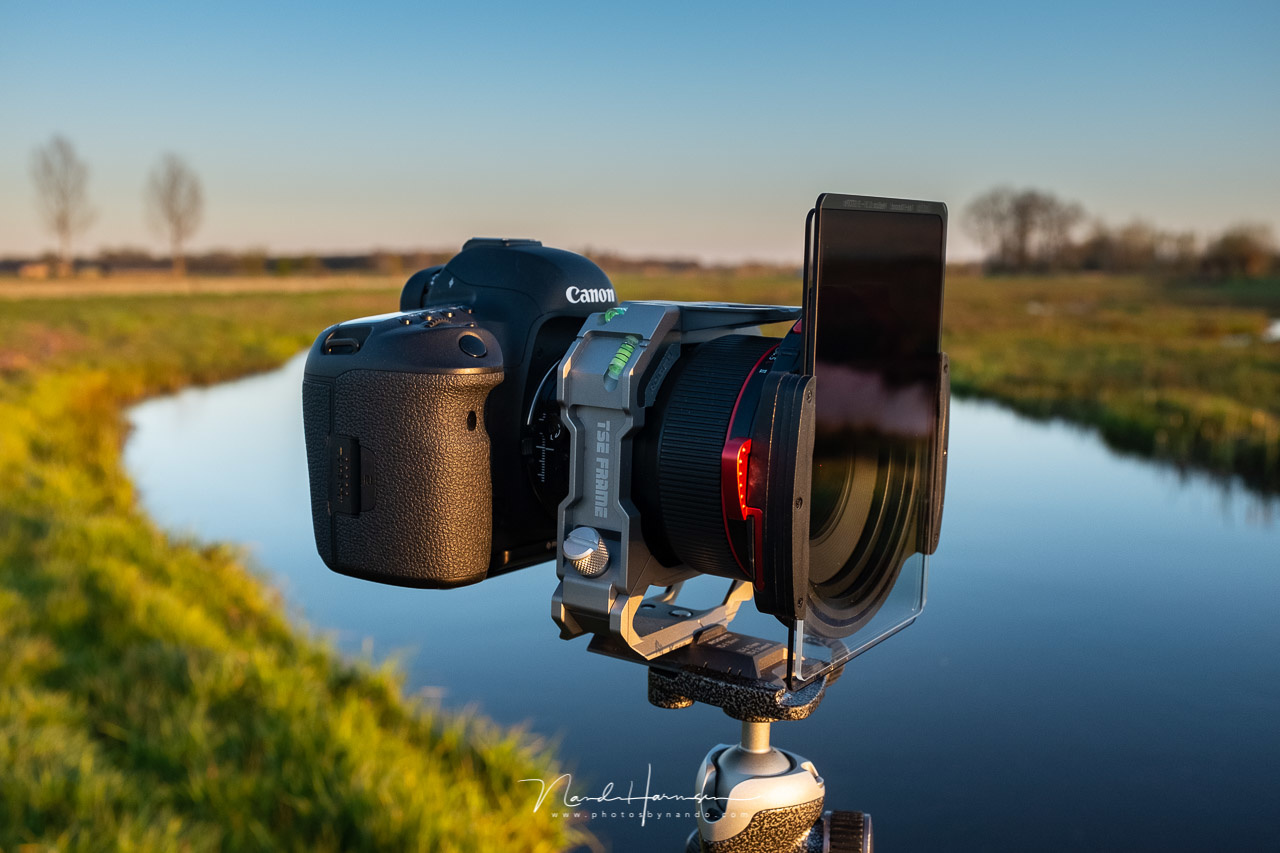
The Rogeti TSE adapter in real life, with a TS-E 24mm f/3.5L II and a set of Haida filters. I used the Rogeti for a landscape panorama of a sunset.
The Rogeti TSE Frame
Rogeti produces some nice panorama products, like a geared tripod head, L-brackets, and some things for GoPro users. Their TSE frame is made from lightweight anodic oxidized aluminum, adding only 215 grams to the lens. It is not cheap, so I was in doubt for a while if I would need this frame for my photography.

The TS-E 17mm f/4L lens fitted in a Rogeti TSE adapter and mounted with the provided nodal slide. It looks impressive, but does it work as it should?
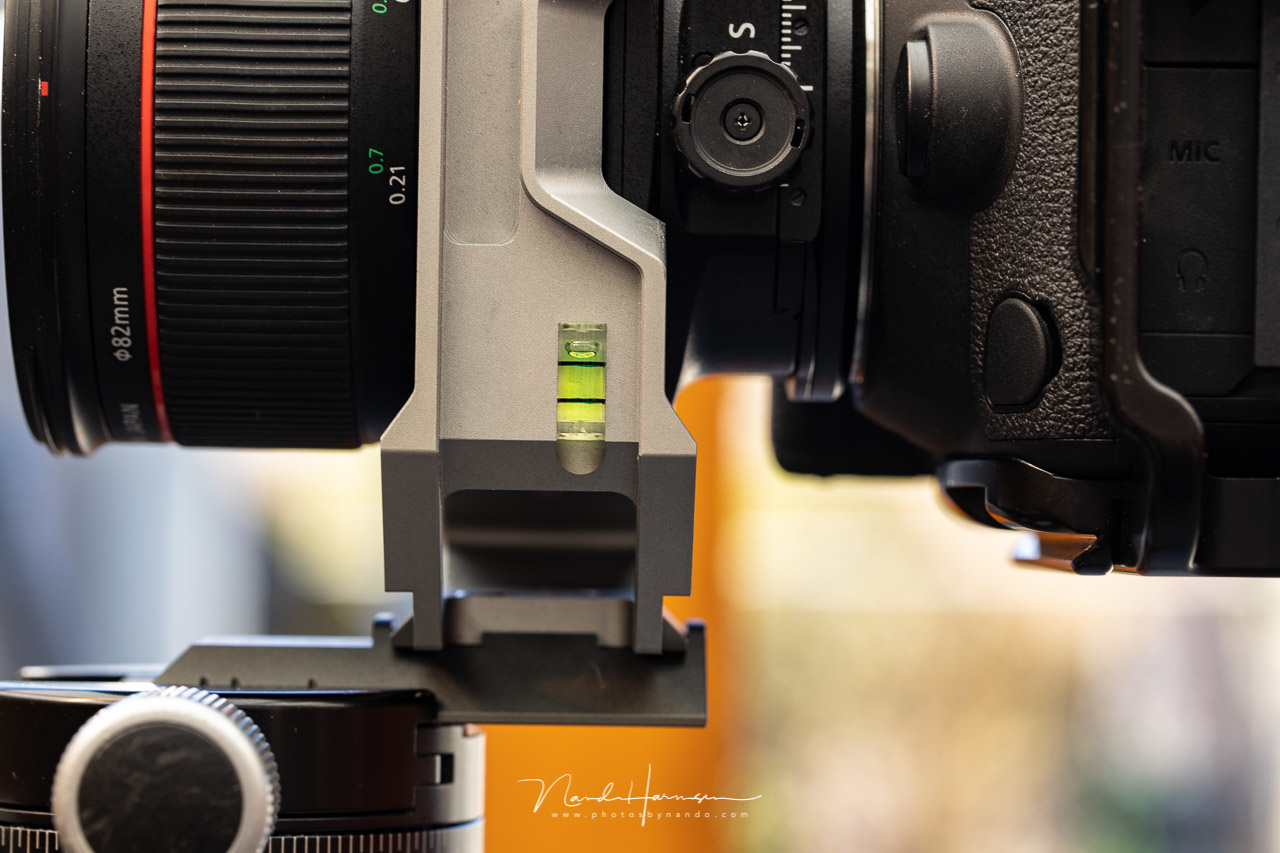
This is how a TS-E 24mm f/3.5L II looks like when fitted into the Rogeti TSE adapter. You can see the shift knob is easy to reach if your fingers are not too thick.
The TSE Frame III (the third version) is very well built. It fits both the TS-E 24mm f/3.5L II and the TS-E 17mm f/4L. A few rubber mounts hold the lens without leaving scratches, and there are four spirit bubbles that match the different angles in which the frame can be used.
Rogeti provides a nodal slide with the TSE frame and a bracket that can carry a smartphone or gray card to block sunlight. This is very handy when using the TS-E 17mm f/4L.

Flares can occur very easily with a TS-E lens. Rogeti has provided a plastic holder for your smartphone. It can block sunlight in some situations.
Installing the TSE frame is very easy. When installed, the frame does have a few issues. It is difficult to reach the knobs, and the distance scale is difficult the read. The depth of field scale is completely blocked. But the biggest issue is perhaps the lost ability to use the tilt option. Although this is the price you pay for adding a tripod collar: it limits the full potential of the tilt-shift lens.

Unfortunately, the focal scale is difficult to see. The depth of field scale is nearly impossible to read. It is a big drawback, I think.
On the other hand, the TSE frame's purpose is for shooting panoramic footage. If the lens is used with the tilt option, you will probably not use it for panoramic shots at the same time. Because it is easy to install or remove the bracket, it won't be a major drawback, I think.

This is not possible with the Rogeti TSE frame: the tilt function. But for those who use the lens for panoramas, they won't be using the tilt a lot.
Panorama Shift Possibilities With the TSE Frame
The idea of the TSE adapter is simple. Those who know something about panoramas and nodal slides know how it works. Instead of moving the lens, the adapter allows you to move the camera instead. This way, the image circle of the TS-E lens will stay at exactly the same position, while the camera shifts to capture the whole diameter of the image circle. This way, you can be sure there is no parallax at all. The next two animated GIFs show how it works

With the adapter, the lens and image circle stay fixed in the same position while the camera shifts.
There are four ways to use the TSE frame for panoramas. If you also count the different orientations, you end up with eight possibilities. First of all, the TSE frame can be used in the horizontal orientation. Second, the TSE frame can also be used in a diagonal orientation, allowing a field of view that is more than 2.5 times the original field of view.

This is possible with the Rogeti TSE frame. (credit: image is borrowed from the Rogeti website (https://rogeti.com/products/tse-frame)
Shooing in a Horizontal Position
By mounting the TSE frame in the regular horizontal position, you are able to shift the camera up and down or left and right. This can be done with the camera in portrait orientation and in landscape orientation
The field of view will be 200% in vertical shift with the camera in landscape orientation or lateral shift in portrait orientation. A vertical shift in portrait orientation will increase the field of view 167%, just like a lateral shift in landscape orientation.
Shooting in a Diagonal Position
When the TSE frame is mounted diagonally, it is possible to shift the camera across both diagonals, increasing the field of view up to 251%. It is possible to use only the top half of the frame, of course, preventing a horizon in the middle. This will increase the landscape orientation to 147% and the vertical orientation to 171%.
If a TS-E 17mm f/4L is used in this way, it is possible to obtain an amazing field of view, with an increase of resolution at the same time. If you don't care about the increased resolution, you could also shoot with a 12mm ultra-wide-angle, ending up with nearly the same angle of view.

By mounting the TSE frame in a diagonal position, you can cover a wider and higher angle of view. Due to the construction of the TS-E lens, this can only be achieved in this way.
Using the TSE Frame in Real Situations
Due to the limited amount of weight, it is easy to leave the TSE frame connected to the lens while transporting it in a camera bag. Using the frame is simple: just place it on the tripod, level the camera, and shoot. Rotating the knob for the shift can be tricky, just like loosening the locking knob. There is not much space between the frame and the camera body. Also, the levers for rotating the camera might be difficult the reach.
When using the frame for vertical panoramas, the weight of the camera requires you to fasten the locking knob. But this is not due to the frame itself, but the way the TS-E lens works. Just like panoramas in the traditional way, with a nodal slide, you have to take your time to properly set up your camera. I don't mind, because it is spending time photographing. This kind of photography is not about speed and shooting quickly before moving on.

Shooting panoramas with the tilt-shift lens and the Rogeti TSE frame is fun. Although you have to level the camera, you can easy tilt the camera up or down without any problem. Just make sure it is kept horizontal.
Although horizontal panoramas are the first thing that comes to mind, the TSE frame is perfect for a vertical panorama. If you used a nodal slide, a vertical panorama would require a 360°/180° setup. The TSE frame allows us to keep the camera horizontal while shifting it from top to bottom. It allows perfect shots with a nice foreground. The first three examples below are made this way, and the last three examples are horizontal panoramas.
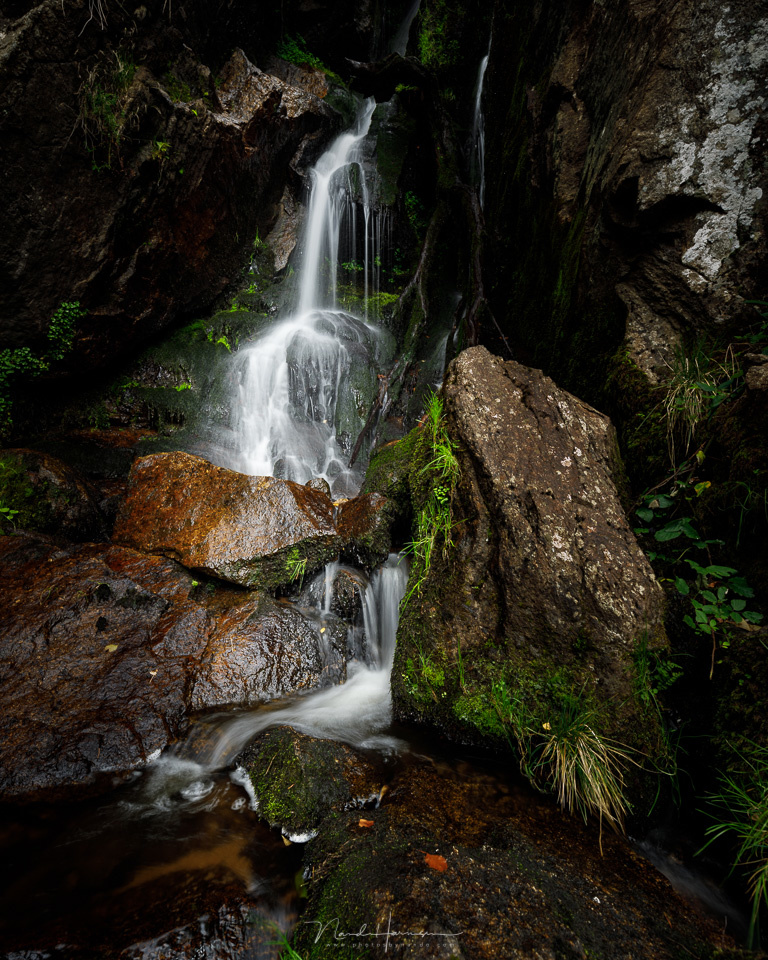
Four images are used in this vertical panorama, with the camera in horizontal position. The location was too tight to get the waterfall in one image. (EOS 5D Mark IV TS-E 24L II, ISO 100, f/11, 1s, Kase CPL filter)
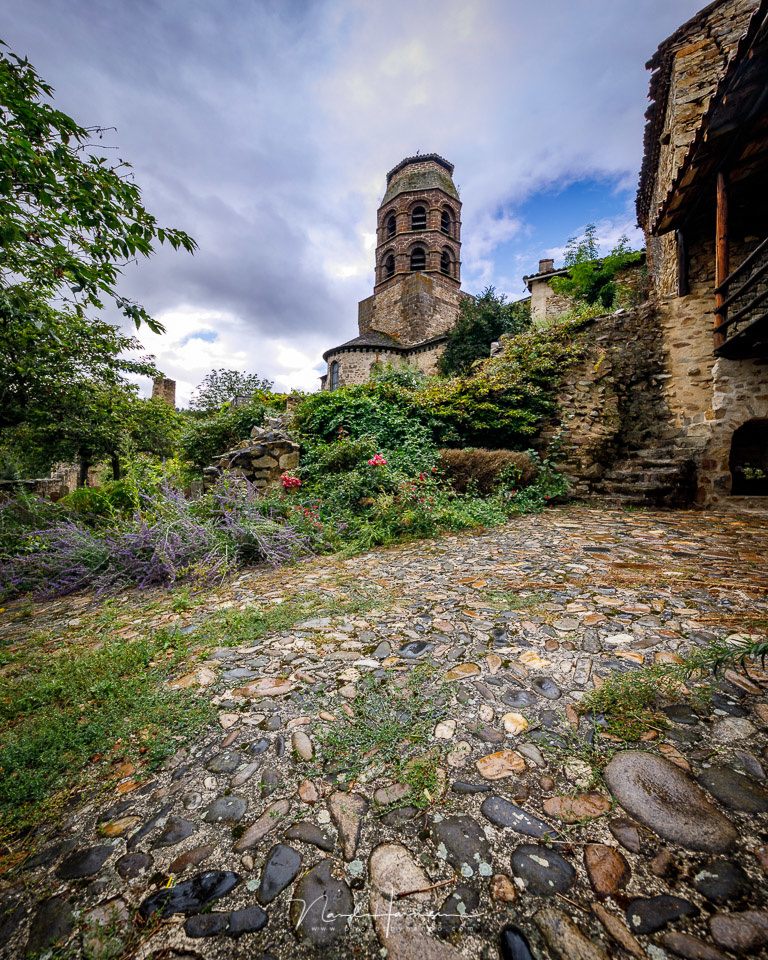
The most beautiful village in France, Lavaudieu. Four horizontal images are used in this vertical panorama, together with focus stacking between those four images. (EOS 5D Mark IV TS-E 17L, ISO 100, f/11, 1/13 s)
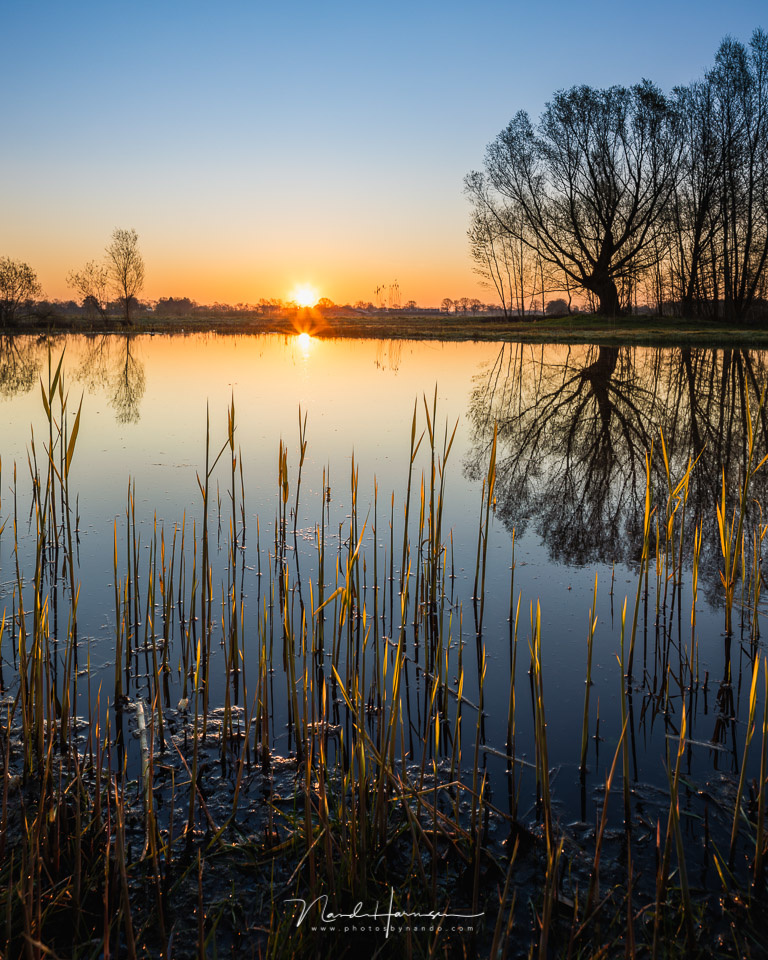
Three horizontal shots are used in this vertical panorama (EOS 5D Mark IV TS-E 24L II, ISO 100, f/11, 1/20 s, Kase Reverse 0,9GND)

Horizontal panorama made from three shots. (EOS 5D Mark IV TS-E 24L II, ISO 200, f/11, 30 s, Kase ND1000)

One of the alleys in the French village of Lavaudieu. A horizontal panorama made from 4 vertical images (EOS 5D Mark IV TS-E 17mm, ISO 100, f/11, 1/13 s)

A horizontal panorama of Fort Mahon, at the French Opal Coast. A horizontal panorama during morning twilight at low tide (EOS 5D Mark IV TS-E 24mm II, ISO 100, f/8, 1/6 s, Kase hard GND0.9 CPL)
I needed to make sure the distance was set correctly, because the depth of field scale is barely visible. Setting the hyperfocal distance becomes a bit tricky. This is the biggest problem with the frame, I think. Although with a bit of practice, you get to know the right distance for a hyperfocal setting. If you want to use the tilt function of the lens for maximum depth of field, you need to remove the TSE frame.
My Conclusion
I had my doubts about this Rogeti TSE frame, especially concerning the price. It is just over $300, and that is a lot. But I decided to give it a try and ordered one. It makes panoramic photos very easy without the risk of parallax. Compared to a nodal slide, there is no rotation, and it will prevent the typical curvature of horizontal lines in panoramas. But at the same time, it will stretch the sides of the image. For landscapes, this is not a real problem, but for real estate, it may give a strange look to the image.
I haven't used it in real estate yet since 24mm and 17mm work well for most of the houses I have to photograph. But I definitely will try soon to see how it turns out. For landscape photography, it gives a nice addition when you already use tilt-shift lenses.
What I Liked
- Avoiding parallax with landscapes
- Four spirit bubbles for every possible orientation
- Lightweight
- Well constructed
- Rubber holders to prevent damage to the lens
- High resistance hinge, stays open for easy assembly
- Nodal slide provided
- Holder for smartphone or gray card to block sunlight
- Usable for the TS-E 17mm and the TS-E 24mm
- Arca Swiss compatible mount
- 3/8" and 1/4" threaded screw hole provided
- Both horizontal and diagonal mount
What I Didn't Like
- No possibility for tilt anymore
- The focal distance scale is not easy to see
- Depth of field scale is almost completely obstructed
- Knobs for shift are not easy to use anymore
- Gun sight is provided but will be blocked by the camera
- A separate holder is needed for the TS-E 50mm f/2.8L
Alternatives
I have found two alternatives on the internet. First, there is the PPL TSE adapter. It is a piece of aluminum weighing 370 grams. It is not as flexible and requires a screwdriver to change the TS-E lenses. It is also much more expensive.
The other one is the Sunway TS-E24 bracket. It is heavier and less flexible compared to the Rogeti TSE adapter. But, just like the PPL, the adapter seems less bulky, thus leaving the focus ring and depth of field graphic visible. The Sunway is less expensive and seems to be a good alternative to the Rogeti.
Your Thoughts
What do you think of a TSE frame for parallax-free panorama with a TS-E lens? Do you think it is worth it, or just a piece of equipment that doesn't add a lot of value? Or perhaps you have an alternative for the Rogeti TSE frame? Please let me know in the comment below.











I have two Agnos Jumbo brackets for my Nikkor PC-E lenses and I love them! Especialliy with subject nearby or macrowork with the 85mm it is a great addition. I modified them slightly to decrease the height.
I did not know this one. It is great how they managed to keep the tilt available. I wish the Rogeti had this too.
Thanks for sharing. Looks like a great product
Yes, it is a great product, afaik the only option for Nikkor PC-E's.
I find if wanting to replicate the "idea" of large format then using a tilt shift lens in this fashion works well. Still life or architecture is where this type of kit works very, very well. The inability to change angle of tilt is where this, for me, misses the mark. I can take a panoramic head and create a landscape that feels like the viewer is in the image because you can bring the closest parts of the foreground even closer to the viewer with defining detail while utilizing the panoramic ability of the head to and a general zoom lens to create wide angles of view while also capturing detailed mid ground subjects. Then when doing a mixed focal length panorama you can take advantage of the additional detail while making the image itself easier to put together in post. Overall, the pano head versus the tilt shift with rotator option, for me, the former is more valuable to me as a creative, but that's again for me and what I like creating. It's a neat piece of kit.
You mention a mixed focal length panorama? Do you mean you change focal length between individual shots while shooting a panorama? Can you explain this because if this is the case, I would love to learn more about that
Sorry for not getting back to you faster. Ya, I can go over it with ya. Just send me a DM on FB.
No Problem. I have send a message on FB
Interesting and detailed article. I’m amazed the niche businesses out there who come up with these devices.. A pity it doesn’t tilt as well. In many ways it’s like using a sledgehammer to crack a nut. For most people it would be overkill but at the top end small improvements matter. For me as tilt shift owner it’s interesting as it performs shift the correct way in that the sensor is moving. Well done on the article. More please.
I will try to write more :)
Thanks for the comment
in 2013 I had a TS-E tripod collar from the Hartblei.eu
the web site still exists, but I don't know, what the status is
I found it very usefull but just too bulky and sent it back
at that time I used my Leica M9, it was my only full frame digital
the second image is a comparison between the 17mm TS-E shifted in all directions and combined to a panorama shot and the overlay with original shots with the other focal lenghts
I can imagine you did find it bulky. Especially when you carry it with you when using such a compact system. I guess you did not like it enough to keep using it.
The comparison is something I noticed also; 12mm ultra-wide angle covers almost the same diagonal field of view. Thanks for sharing. It is a great addition to the article
How hard are these rubber mounts? Do they leave indentations on the lens barrel after long time use?
These rubber mounts do not tighten the lens enough to leave any mark. The bracket fits real snug without any presure.
I don't see any marks whatsoever. :)
I’ve been tempted to pick one of these up—I have both the 24 and 17mm TS-E lenses... I just have a gut feeling I wouldn’t use it all that much. Also, I haven’t had any parallax issues with creating shifted panoramas... I’m sure this would help but is it worth $300? I don’t know. I am very tempted to pick up the geared tripod head Rogeti just released however!
Actually, I remember one or two times where I wish I had this where I had to try and get more of the structure I was shooting in the frame. The first time I didn’t even have the 17, so I created a less than ideal “crop” of the scene by shifting the 24 to its limits. But the second time I was pushing the 17 to the limits by shifting and I recall that stitching that mofo together afterwards was not easy...
I understand your dilemma. I experienced the same dilemma.
It is always possible to choose for rotating the lens around the entrance pupil with a nodal slide. It is less expensive, and it works if you don't use the shift function
there is a very big difference:
if you shoot images from one image circle like a TS-E lens or a medium format lens
or you rotate the lens!
When you rotate a lens, even with perfect nodal point correction, you always get distortions like round lines of buildings. To a certain degree you may correct it in post, but you have to add new calculated pixels. This is a problem with architecture but of course less in landscape.
I add a picture with a Sony Nex-7 (infrared converted) adapted to a Hasselblad lens with a Rhinocam adapter. This adapter allows to move the camera and shoot multiple images in two rows, that fit perfectly to one high res high megapixel image
and one more a Nex-6 with the same adapter mounted on a 4x5" back of a Gandolfi camera. With this you may use the full shift and tilt options of the large format and get images of up to a few hundred megapixel
happy shooting
dierk
You are absolutely correct. When rotating the setup you will end up with straight lines being bended (I hope I said that in the correct way). This was one of the reasons to choose a tiltshift lens for panorama shots.
But for landscapes it isn't that obvious, as long as you don't make panorama's that are more than - let's say 120° - . For architectural images it will be seen immediately.
If you are shooting panoramas just once or twice, the nodal slide will be a good alternative, even when you need to corret the image in post. It saves you a lot of money. But if you need to shoot a lot fo these images, it becomes interesting, I think.
I love to see your setup. Both of them. I think it is a better sollution than a tilt-shift with a bracket.
But less easy to take with you.
Thanks for sharing. :)
with this setup there is a huge limitation compared with a 24mm or even 17mm TS lens!
you are obviously limited to the available wide angle lenses for medium format with about 40mm and for the large format of about 90mm.
But if this is ok. for the job, it is great. I love for example the Zeiss 120mm macro lens of the Hasselblad for product shots - or I use the 85mm PC Micro Nikkor and have tilt and shift and stitching all together :-)
I have the impression, that I could offer a separate on this topic post to Fstoppers :-)
last example: Sony A6000 with 85mm PC Micro Nikkor with tilt and stitched shifted,
printed 2m wide :-)
Recently I used the Fujifilm GF 23mm lens for the (almost) medium format sensor GFX100 camera. And I believe there are already some shorter focal length available for those cameras. Are these lenses a possibility for your setup?
it is called medium format, but with 44 x 33 mm it is in the middle between 35mm and the normal 6x6cm (56x56mm) format of the lenses, I used. When you stitch two 24 x 36mm you may get 48 x 36mm and this is even more than the GFX100 offers, and with a 42 MPix sensor the resolution is very close, not to mention the new 60 MPix sensors. The image circle of a 44 x 33 camera will be much smaller than with a normal 6x6 camera and will not support more that two shots for stitching. Besides that, I assume, that the lenses for the GFX need the electronics from the camera to operate the diaphragma.
One more example
Sony A6000 with Zeiss Makro-Planar 4/120mm on Rhinocam adapter
stitched from 12 (4x3) images, 180 MP, 13.400 x 13.400 pixel
and a 1:1 crop
judge yourself :-)
Nando,
I would like to add some experiences with 17mm TS-E stitching.
I do stitching with any lens since about 15 years, some with a nodal corrected pano head, some with tripod but most hand held
all pictures with 17mm TS-E
the first picture with tripod and shift left and right and compensated the 12mm shift on a macro rail by the same amount (Leica M9)
the second picture with very close foreground from tripod 3 images in portrait orientation, no problems with the foreground (Leica M9)
the third image in a church two images hand held! in panorama orientation (Sony A7RII)
as long as there is not a too close foreground I don't see any problem
Thank you for showing the examples.
You are correct. Without a nearby foreground it won't be any problem.
There‘s also an adapter option by German company pocket pano and they chose a significantly different approach. I think their adapter is the lightest and smallest on the market and it enables tilt as well...
I bought it about a year ago as the Rogeti was double the price compared to the Pocket Pano version. So far I‘m happy with mine. But man, I‘d love to have the diagonal shift function that is built into the new Rogeti adapter.
I have checked this product.
The pocket pano is nothing more than a regular nodal slide setup for 360°/180° panoramas. Nothing wrong with i, but not primarily for tilt-shift lenses.
Hey Nando, thank you for your immediate reply. I‘m not sure if we‘re talking about the same product. This is what I meant:
https://www.pocketpano.de/deutsch/rear-tilt-n-shift-frame/
It offers rear shift just as the Rogeti or the sunwayfoto
I am sorry, I missed this one. y mistake.
Looks like a great product. But only for the TS-E 17L if I am not mistaken? Would be great if it also would fit the TS-E 24L
I guess that‘s not your fault. They didn‘t really announce this anywhere publicly as far as I know and I just happened to know it by accident. Being German myself might have helped, too.
There‘s one frame for the 17+24mm TS-E and they have a brand new one for the 50mm as well now. Just like the line-up/compability of the Rogeti frames.
By the way. Designwise I prefer the Rogeti frame by a lot. It just looks way cooler 😂 plus the 45 degree position of the Rogeti frame is also a nice benefit, as the PocketPano doesn’t offer the same convenience when stitching diagonally.
A tripod mount at a 45° location would fix this easily. I wonder why they didn't incorporate this
I can tell you as I asked them multiple times 😀. They have the two positions in 90 degree position to fully enable every possible combination of shift and tilt mechanism.
And they said it‘s easy enough to just rotate the tripod head about 45 degrees to enable diagonal shifts. While this might be true I think this still brings some problems when using just about any head except for accurately centred heads like the cube. For example, using the Manfrotto heads: when tilting the tripod head to 45 degree one‘s moving the entire camera setup about 10cm to the side and this might destroy the perfectly aligned camera position forcing to compose everything again.
They even told me it‘d been no problem to add the third tripod mount in between, they just didn‘t see it as a benefit. I disagreed but for now the design will remain as it is.